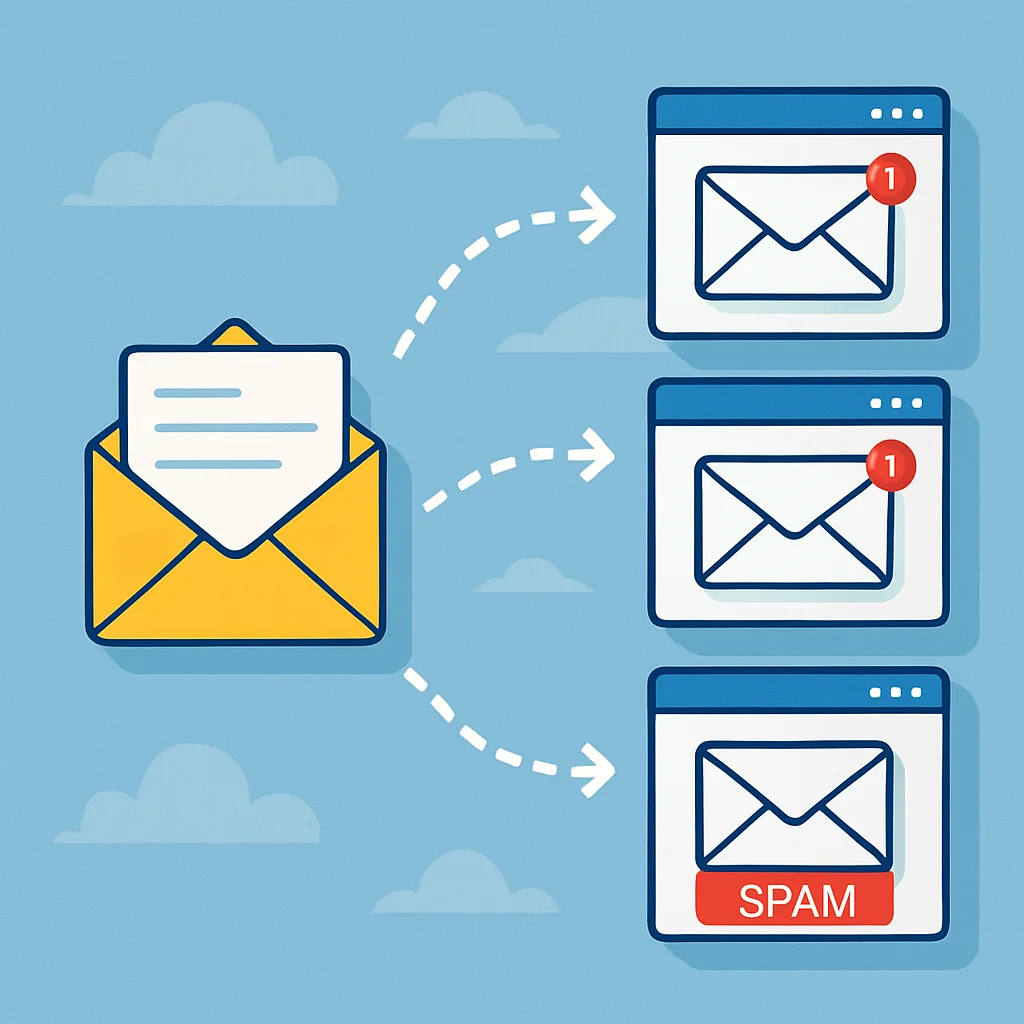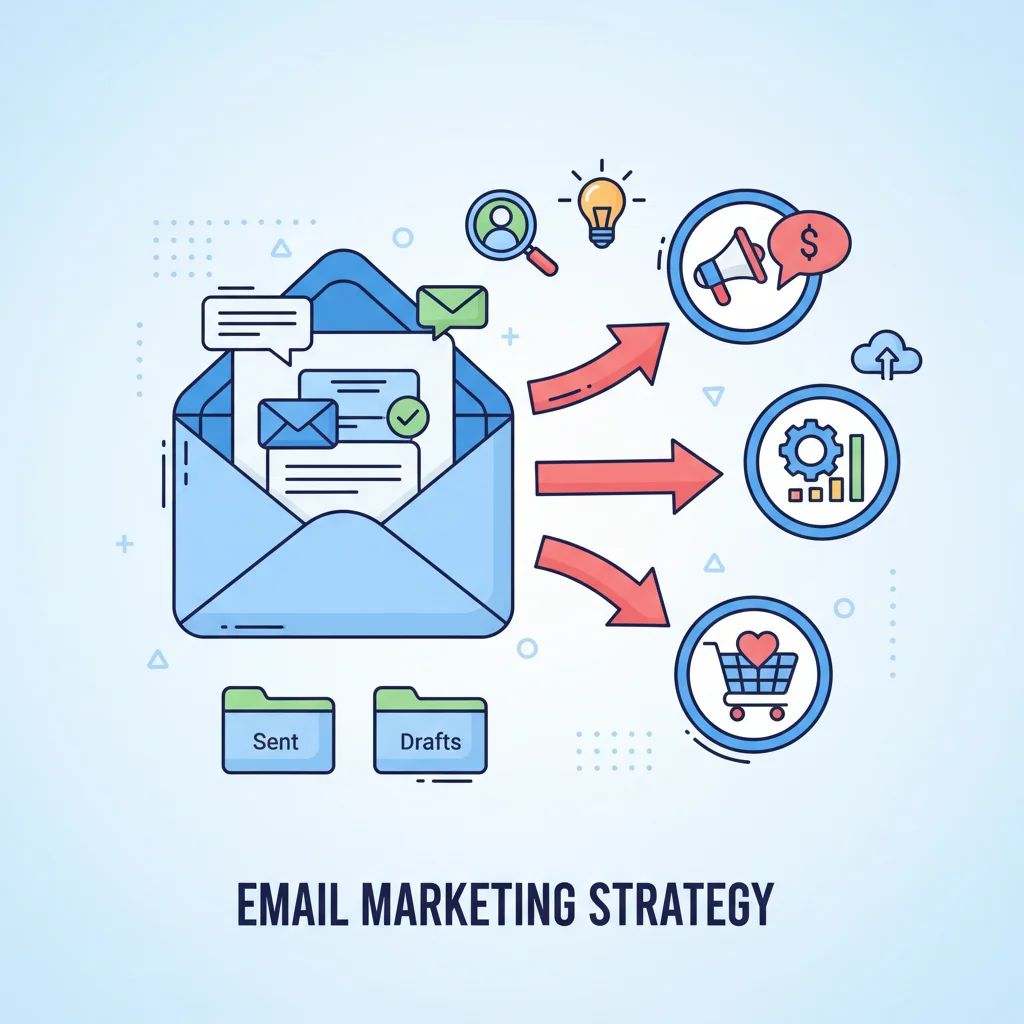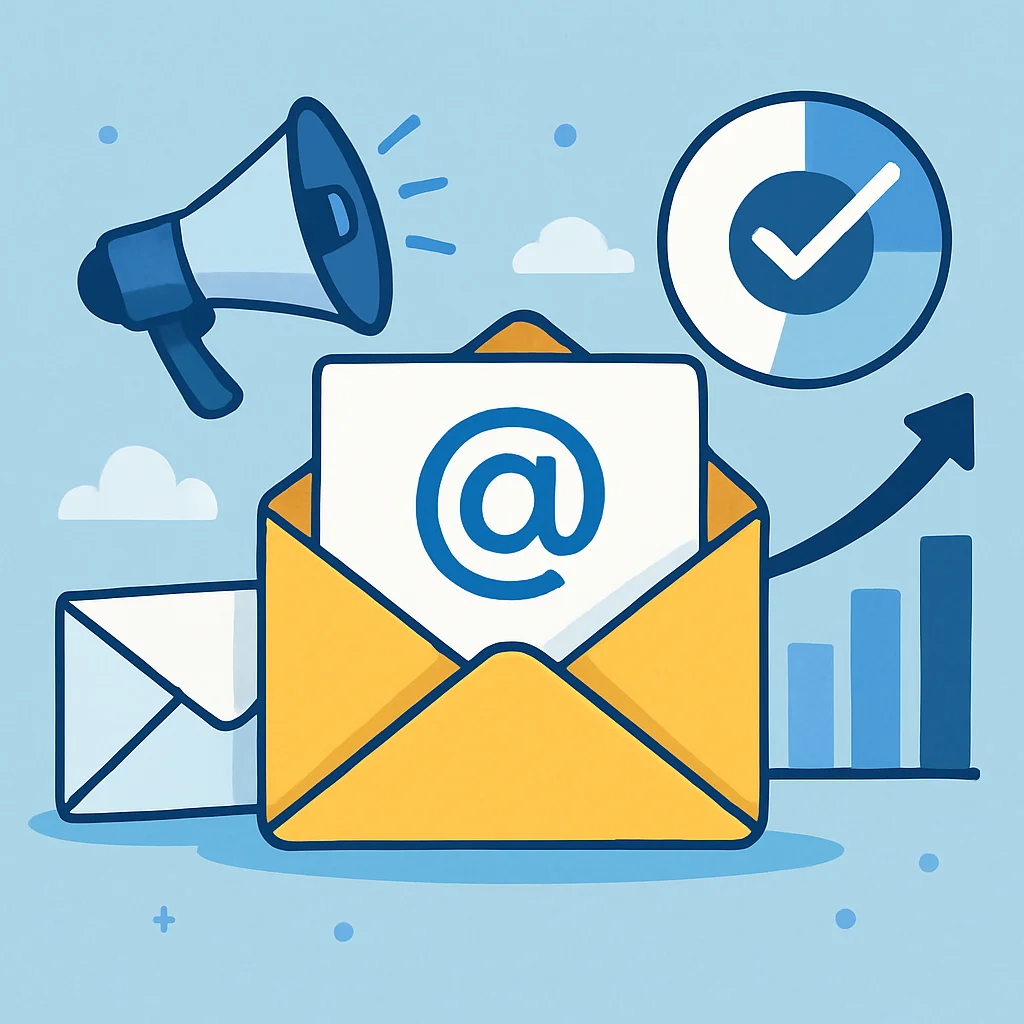Now Reading: Prevent Marketing Emails From Going to Spam: Expert Guide
-
01
Prevent Marketing Emails From Going to Spam: Expert Guide
Prevent Marketing Emails From Going to Spam: Expert Guide

Did you know that about 20% of all marketing emails never reach the inbox? That’s one in five emails you send disappearing into the digital void! For businesses relying on email marketing, that’s a potential revenue disaster. I’ve spent years figuring out how to prevent marketing emails from going to spam, and I’m excited to share these game-changing strategies that have helped me achieve 90%+ inbox placement rates.
Key Takeaways
- Authentication is crucial: Implement SPF, DKIM, and DMARC to verify your identity to email providers
- Keep your lists clean: Regularly remove inactive subscribers and honor unsubscribes immediately
- Create engaging, non-spammy content: Avoid excessive caps, exclamation points, and spam trigger words
- Warm up new IP addresses gradually by sending small batches of emails before scaling up
- Maintain consistent sending patterns rather than sudden large blasts that trigger spam filters
- Use a reputable email service provider with good deliverability infrastructure
- Test your emails before sending to identify potential spam triggers
Why Your Marketing Emails End Up In Spam
Let’s get real for a second. Spam filters have gotten crazy sophisticated. They’re like those overprotective parents who screen all your friends before letting them into the house. Except in this case, your marketing email is the friend trying to get past the bouncer.
I’ve seen perfectly innocent emails get flagged for the weirdest reasons. Sometimes it’s because you used the word “free” too many times. Other times it’s because your sending reputation is about as trustworthy as a cat near an unattended sandwich.
The main reasons your emails might be taking the express route to Spamville include:
- Poor sender reputation (previous spam complaints haunt you)
- Missing email authentication (no ID at the email club door)
- Spammy content or formatting (YOU LOOK LIKE YOU’RE SHOUTING!!!)
- Low engagement rates (nobody’s opening or clicking)
- Dirty email lists (sending to old or invalid addresses)
Understanding these triggers is your first step toward solving the problem. Now let’s dive into the solutions.
Useful Articles:
Email Authentication: Your Digital ID Card
What Is Email Authentication?
Think of email authentication as your digital ID card. Without it, you’re just some random person trying to slide into someone’s inbox. Email providers are like, “Who are you again? To the spam folder you go!”
Email authentication protocols verify you are who you say you are. They’re technical, yes, but absolutely essential if you want to prevent marketing emails from going to spam.
Setting Up SPF Records
SPF (Sender Policy Framework) tells email providers which mail servers are authorized to send emails on behalf of your domain. Setting it up isn’t as complicated as it sounds:
- Access your domain’s DNS settings (through your domain registrar)
- Create a TXT record that lists all servers authorized to send email from your domain
- A basic SPF record looks something like:
v=spf1 include:_spf.google.com ~all
This basically says “Hey, Google’s servers can send emails for me, but be suspicious of anyone else.”
Implementing DKIM
DKIM (DomainKeys Identified Mail) adds a digital signature to your emails that verifies they haven’t been tampered with in transit.
To set up DKIM:
- Generate a public/private key pair
- Add the public key to your DNS records
- Configure your email sending system to sign outgoing messages with the private key
Most good email service providers make this pretty straightforward with step-by-step instructions.
Configuring DMARC
DMARC (Domain-based Message Authentication, Reporting & Conformance) builds on SPF and DKIM by telling receiving servers what to do with emails that fail authentication.
A basic DMARC record might look like:v=DMARC1; p=none; rua=mailto:reports@yourdomain.com
This says “monitor emails claiming to be from my domain and send reports to this address, but don’t take any action yet.”
Once you’re confident in your setup, you can change p=none to p=quarantine or p=reject to tell receivers to treat unauthenticated emails as suspicious or reject them entirely.
List Hygiene: Clean Lists = Better Deliverability
The Importance of List Quality
Your email list is like your garden. Let it get overgrown with weeds (inactive subscribers, wrong addresses), and nothing healthy will grow.
I once worked with a client who hadn’t cleaned their list in THREE YEARS. Their deliverability was in the toilet. After a proper cleanup, their inbox placement improved by 34%!
Quality always beats quantity when it comes to email lists. I’d rather have 1,000 engaged subscribers than 10,000 who never open my emails.
Regular List Cleaning Practices
Here’s my tried-and-true process for keeping lists squeaky clean:
- Remove hard bounces immediately – These are invalid addresses that will hurt your reputation
- Segment inactive subscribers – If someone hasn’t opened your emails in 6 months, they’re dead weight
- Run a re-engagement campaign for inactives before removing them
- Use double opt-in for new subscribers to verify email addresses
- Scrub your list quarterly at minimum
I use a simple rule: If they haven’t engaged in 9 months despite re-engagement attempts, they gotta go. Harsh but necessary.
Handling Unsubscribes Properly
Nothing screams “SEND ME TO SPAM” like ignoring unsubscribe requests. Besides being legally required (hello, CAN-SPAM and GDPR), promptly processing unsubscribes is crucial for deliverability.
Make sure your unsubscribe process is:
- One-click simple – Don’t make people log in or jump through hoops
- Immediate – Process requests within 10 days maximum (24 hours is better)
- Permanent – Once they’re off, keep them off unless they explicitly re-subscribe
I’ve seen companies try to hide their unsubscribe links or make the process confusing. Don’t be that marketer. It’s a fast track to spam complaints.
Useful Articles:
Content Best Practices To Avoid Spam Triggers
Writing Non-Spammy Subject Lines
Your subject line is like the headline on a newspaper. It either grabs attention or gets ignored. But there’s a fine line between attention-grabbing and spam-triggering.
Avoid these subject line no-nos:
- ALL CAPS (looks like you’re yelling)
- Excessive punctuation (Buy Now!!!!!!)
- Spam trigger words (“Free”, “Guarantee”, “No risk”)
- Misleading promises (“Make $5000 in one day”)
Instead, try these approaches:
- Be specific and relevant: “Your May Photography Tips Inside”
- Create curiosity: “This changed how I approach email marketing”
- Add personalization: “John, your custom report is ready”
- Use numbers: “5 ways to improve your open rates”
Balancing Text and Images
Ever received an email that’s just one giant image? Spam filters hate those. They can’t read images, so they assume you’re hiding something.
For better deliverability:
- Maintain a healthy text-to-image ratio (aim for at least 60% text)
- Always include alt text for images
- Don’t hide important information in images
- Avoid image-only emails entirely
One of my clients reduced their image-heavy template to a more balanced design and saw spam placement drop by 15%. Worth it!
Avoiding Spam Trigger Words and Phrases
Certain words make spam filters twitchy. The obvious ones include:
- “Free”
- “Guarantee”
- “No obligation”
- “$$$$”
- “Act now”
- “Limited time”
But context matters too. “Free consultation” in a B2B email is less likely to trigger spam filters than “FREE CASH NOW!!!”
A good practice is to run your content through spam checking tools before sending. Most email platforms have this feature built in.
Proper Link Usage
Links are essential in marketing emails, but they can also be spam magnets if used incorrectly:
- Avoid link shorteners when possible – they’re often used by spammers
- Don’t hide links behind misleading anchor text
- Limit the number of links – too many looks suspicious
- Make sure destinations are secure (https://)
- Use your own domain in links when possible
I once reduced links in a newsletter from 12 to 6, focusing on quality over quantity, and saw a 9% improvement in inbox placement. Sometimes less really is more.
Sending Practices That Improve Deliverability
IP Warming Strategies
If you’re sending from a new IP address, you can’t just blast emails to your entire list on day one. That’s like showing up to a party where nobody knows you and immediately trying to sell everyone something. Weird, right?
Instead, warm up your IP gradually:
- Week 1: Send to your most engaged 10% of subscribers
- Week 2: Increase to 25%
- Week 3: Move to 50%
- Week 4: Ramp up to 75%
- Week 5: Full sending volume
This gradual approach builds your sending reputation before you hit full volume.
Consistent Sending Patterns
Email providers love consistency. Sudden spikes in volume look suspicious.
For example, if you normally send 5,000 emails weekly, then suddenly blast 50,000, spam filters will raise eyebrows. Instead:
- Establish a regular sending schedule
- Maintain similar volume from send to send
- If you need to increase volume, do it gradually
- Send at consistent times of day/week
Your subscribers also appreciate consistency-they’ll start to expect and look for your emails.
Segmentation and Personalization
Blasting the same generic message to everyone is so 2005. Modern email marketing requires segmentation and personalization.
Why this helps prevent spam:
- Higher engagement rates (opens, clicks) signal to providers your content is wanted
- More relevant content means fewer spam complaints
- Targeted sending often means better timing and frequency
Some easy segmentation strategies:
- By purchase history
- By engagement level
- By demographics
- By content preferences
- By position in the customer journey
I’ve seen open rates double simply by breaking one large list into three targeted segments. The effort pays off big time.
Useful Articles:
Technical Setup For Better Deliverability
Choosing a Reputable Email Service Provider
Your ESP (Email Service Provider) is like your email sending partner. Choose poorly, and you’re guilty by association.
Good ESPs maintain their own IP reputation and provide:
- Built-in authentication tools
- Deliverability monitoring
- Spam testing
- Bounce handling
- Compliance features
Popular reputable options include:
- Mailchimp
- Campaign Monitor
- Klaviyo
- HubSpot
- ActiveCampaign
If you’re on a shared IP with an ESP, you’re sharing reputation with other senders-so choose a provider that enforces good sending practices.
Setting Up Proper DNS Records
Beyond authentication records (SPF, DKIM, DMARC), other DNS settings matter for deliverability:
- rDNS (reverse DNS) – Makes sure your sending IP resolves back to your domain
- BIMI records – Allow your logo to appear in supporting inboxes
- MX records – Properly configured mail exchanger records
These technical details might seem minor, but they signal to email providers that you’re a legitimate, professional sender who knows what they’re doing.
Monitoring Your Sender Reputation
You can’t improve what you don’t measure. Regularly check your sender reputation using tools like:
- SenderScore.org
- Google Postmaster Tools
- Microsoft SNDS
- Return Path
A dropping reputation is an early warning sign of deliverability problems. I check mine monthly at minimum.
Testing And Optimization
Pre-Send Spam Testing
Before hitting send on any campaign, run it through spam testing tools. Most ESPs offer this, or you can use specialized services like:
- Litmus
- Email on Acid
- MailGenius
These tools check your content against common spam filters and give you a deliverability score with specific improvement recommendations.
I never send an important campaign without testing first. It’s saved me from spam folder purgatory countless times.
A/B Testing For Deliverability
Most marketers A/B test for opens or clicks, but you can also test for deliverability:
- Test different subject lines to see which avoids spam filters
- Compare different content-to-image ratios
- Test link quantities
- Compare different sending times
Keep variables isolated-change one thing at a time so you know what made the difference.
Monitoring Deliverability Metrics
Pay attention to these key metrics:
- Inbox placement rate – What percentage of emails actually reach the inbox?
- Bounce rate – Should stay under 2%
- Spam complaint rate – Should stay under 0.1%
- Block/deferral rates – Indicates reputation issues
Most ESPs provide these metrics, though specialized deliverability tools give more detailed insights.
Engagement Strategies That Boost Inbox Placement
Creating Valuable, Relevant Content
This should be obvious, but the best way to stay out of spam is to send emails people actually want. Revolutionary concept, I know!
Focus on:
- Solving real problems for your audience
- Providing genuine value in every email
- Making content so good they’d miss it if it stopped coming
I’ve found that educational content generally performs better than pure promotional content for deliverability. A good mix is 80% value, 20% promotion.
Encouraging Subscriber Interaction
Email is a two-way street. Providers like Gmail look at subscriber engagement as a key signal for inbox placement.
Boost engagement by:
- Asking questions
- Including polls or surveys
- Requesting replies
- Adding interactive elements
- Encouraging forwards and shares
One simple tactic: occasionally send emails that explicitly ask for a reply. The responses not only provide valuable feedback but also signal to email providers that your messages are wanted.
Setting Proper Expectations
The relationship starts before the first email. Set clear expectations during the signup process:
- What content will they receive?
- How often will they hear from you?
- What value will you provide?
Then-this is crucial-deliver on those promises. Nothing triggers spam complaints faster than unmet expectations.
I always include a “What to expect” section on signup forms and welcome emails. It sets the relationship off on the right foot.
Handling Deliverability Issues
Diagnosing Spam Placement Problems
If you notice your emails landing in spam, don’t panic. Start diagnosing:
- Check your authentication – Are SPF, DKIM, and DMARC properly configured?
- Review recent content changes – Did you change your template or messaging?
- Look at engagement metrics – Have opens and clicks dropped?
- Check your sender reputation – Has your score decreased?
- Analyze spam test results – What specific issues are flagged?
- Review bounce and complaint rates – Are they higher than normal?
Finding the root cause is half the battle.
Recovery Strategies
If you’ve identified problems, here’s how to recover:
- Fix technical issues first – Authentication, DNS, etc.
- Clean your list aggressively – Remove all inactive subscribers
- Reduce sending volume temporarily – Focus on your most engaged subscribers
- Simplify your templates – Go text-heavy with minimal images and links
- Ask subscribers to whitelist you – Include instructions in your emails
- Consider changing IPs if your current one is severely damaged
Recovery takes time and patience. I’ve seen it take anywhere from 2 weeks to 3 months to fully restore deliverability, depending on how bad the damage was.
Ongoing Monitoring
Set up a regular monitoring routine:
- Weekly checks of key deliverability metrics
- Monthly sender reputation reviews
- Quarterly list cleaning
- Regular seed testing to different email providers
Catching problems early makes them much easier to fix.
Compliance And Best Practices
Understanding Email Regulations
Compliance isn’t just about avoiding fines-it directly impacts deliverability. The major regulations to know:
- CAN-SPAM Act (US) – Requires honest subject lines, valid physical address, and easy unsubscribe options
- GDPR (EU) – Requires explicit consent, data protection measures, and right to be forgotten
- CASL (Canada) – Requires express or implied consent and easy unsubscribe mechanisms
Non-compliance can lead to both legal penalties and deliverability problems.
Permission-Based Marketing
Always, always, ALWAYS use permission-based marketing:
- Get explicit consent before sending
- Document when and how consent was obtained
- Never buy email lists (seriously, just don’t)
- Provide clear opt-out methods
I’ve never seen a purchased list perform well for deliverability. Ever. They’re poison for your sender reputation.
Transparency And Trust Building
Build trust through transparency:
- Use a consistent, recognizable sender name
- Include your physical address
- Make your privacy policy easily accessible
- Be clear about how you’ll use subscriber data
- Honor preferences and promises
Trust takes time to build but seconds to destroy. Protect it carefully.
Preventing marketing emails from going to spam isn’t a one-time fix-it’s an ongoing process of best practices, monitoring, and optimization. By implementing these strategies, you’ll see more of your carefully crafted messages landing exactly where they belong: in your subscribers’ inboxes, ready to be opened, read, and acted upon. Your deliverability journey might take some work, but the improved results make it all worthwhile. Keep testing, keep improving, and keep providing value-your inbox placement rates will thank you.




















